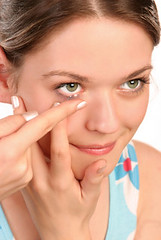Looks like contact lenses are also in the league of joining the ‘Go-Green’ bandwagon. Researchers at McMaster University have found out that a common fluid ‘hyaluronic acid’ found in our bodies can be used as a natural moisturizing agent in contact lenses.

It was shown that this fluid can be entrapped in existing contact lens material without affecting its optical properties. Not only that, using hyaluronic acid considerably reduced the build up of proteins which can cloudy contact lens material, the cause of up to 30 per cent of all after-care visits by contact lens wearers to optometrists.
For your information, Hyaluronic acid is a natural polymer that acts to reduce friction. An average person weighing 70-kg has about 15 grams of hyaluronic acid in their body, one third of which is turned over daily.
The body uses hyaluronic acid to repair skin, provide resiliency in cartilage, and contribute to the growth and movement of cells, among other things. It is also used by the medical profession to treat patients with dry eyes, in cataract surgery, and for other eye-related procedures.
Currently contact lenses use synthetic materials as wetting agents to prevent eye dryness and to increase the comfort-level of the wearer. But they do cause some discomfort due to dryness after long hours of wearing and this is one of reasons why several contact-lenses users stop its usage after some time.
Though manufacturers have not yet produced contact lenses with hyaluronic acid, the researchers remain hopeful.

It was shown that this fluid can be entrapped in existing contact lens material without affecting its optical properties. Not only that, using hyaluronic acid considerably reduced the build up of proteins which can cloudy contact lens material, the cause of up to 30 per cent of all after-care visits by contact lens wearers to optometrists.
For your information, Hyaluronic acid is a natural polymer that acts to reduce friction. An average person weighing 70-kg has about 15 grams of hyaluronic acid in their body, one third of which is turned over daily.
The body uses hyaluronic acid to repair skin, provide resiliency in cartilage, and contribute to the growth and movement of cells, among other things. It is also used by the medical profession to treat patients with dry eyes, in cataract surgery, and for other eye-related procedures.
Currently contact lenses use synthetic materials as wetting agents to prevent eye dryness and to increase the comfort-level of the wearer. But they do cause some discomfort due to dryness after long hours of wearing and this is one of reasons why several contact-lenses users stop its usage after some time.
Though manufacturers have not yet produced contact lenses with hyaluronic acid, the researchers remain hopeful.
What a fantastic idea. I didn't know about this. I am adding this to the Fashion Web tour for the weekend. Contacts are fashion accessories, too! :)
ReplyDeleteThanks. :)
ReplyDelete